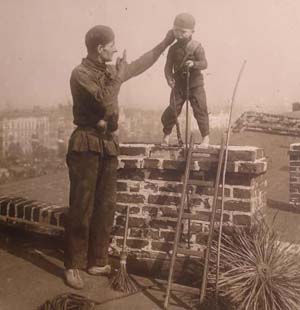Background information about the Chimney Sweep
November 2, 2014 in Background information about the Chimney Sweep

Because of their long history
and stories from ancient folklore, today, a
chimney sweep is a sign of good
luck, wealth, and happiness. As
the story goes, a chimney sweep
saved the life of a horse rider
on a panicked horse galloping
through the cobblestone streets
of a large town. To the town’s
peoples’ surprise, the rider was
the king of the town. The
chimney sweep had disappeared
into the crowd before the king
could formally thank him in
person. From that day on, the
king declared all chimney sweeps
to be lucky and the legend has
lasted to this day.
Chimney sweeps have existed for many centuries. In the 1600’s in Central and Eastern Europe, chimney sweeping was an unfortunate industry because sweeping labor was performed by young, small orphan boys who were forced down narrow chimneys in exchange for food and shelter. These boys would climb down and clean the chimneys under the supervision of the master sweep. The young sweep used metal scrapers on ropes to scrape chimneys free of creosote from inside. The work was difficult as flues
were narrow and thick soot is filthy. The work was extremely dangerous and some children would choke to death
from the poor air quality or they would get infections from being hurt and not having the correct protective clothing. Because the job involved child slave labor and it posed the risk of injury and death, it was considered an unethical violation to humanity and rightfully
using children for the work was outlawed.
In the 1800’s, expert inspection and evaluation of fireplaces and chimneys was left up to the discretion of chimney service technicians. Now, there are standards and codes established by the National Fire Protection Association (NFPA) regarding home heating appliances, fireplaces, and chimney safety called the NFPA 211. The primary job of a chimney sweep is to aid in the prevention of fires related to chimneys and the fireplaces, woodstoves, gas, oil and coal heating systems that they are attached to. Chimney sweeps install, clean and maintain these systems, evaluate their performance and recommend repairs. They also educate the homeowner about their safe and efficient operation. Most of the work your sweep will perform is the annual cleaning of your chimney, where they will remove any accumulated creosote. Creosote is the black combustible soot that sticks to the interior of your chimney and it's a natural byproduct of firewood. As long as man has had fire, we have had soot, which is why the history of the chimney sweep goes back so many centuries.



